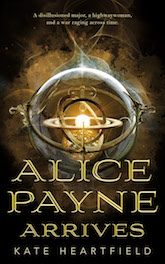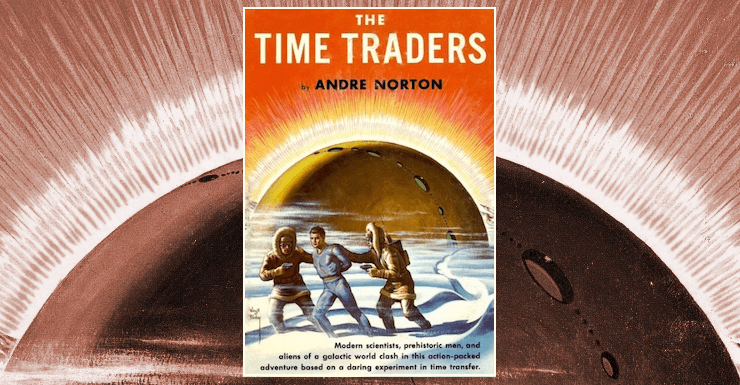Now this is more like it. It’s the book I thought I was getting when I read The Crossroads of Time. Not that that didn’t turn out to be a nice adventure, but I was expecting travel to past and future, rather than parallel worlds.
And here it is.
Petty criminal Ross Murdock—Norton liked this name, as witness Murdoc Jern of The Zero Stone and Uncharted Stars—is in deep legal trouble, but the judge offers him an out: to sign on to a government project. He’s not told what it is or where it is or what it does, only that his sole alternative is serious jail time.
Ross chooses the unknown, which turns out to be the first test. There will be many more, and many mysteries, until he learns that he’s been “volunteered” for a top-secret gig as a time traveler. The technology is extremely advanced but also incalculably ancient. The agents’ mission is to find the source. They do this by dropping small groups of paired agents into specific timelines to search for signs of the ancient tech.
As to the identity of the original time travelers, speculation ranges from humans or other terrestrial beings whose entire culture was expunged by one of the ice ages (presumably they used no metals, and all their natural fibers and plastics have dissolved), to aliens from space.
Naturally there’s an antagonist. The book was published in 1958 and makes specific reference to Sputnik. Ross’ story begins along about 1980, in a world that turned away from space travel and doubled down on the US-Soviet conflict, resulting in what Norton calls a “cold peace.” Now the two superpowers are dueling in secret to find the source of the time machines.
The rules of time travel are strict. No interference. No visible tech beyond that of the time. Agents are trained exhaustively to blend in with contemporary cultures, for their own safety as much as to keep from changing the future.
Ross is a natural for this job. He’s extremely bright and extremely independent-minded, but he can be persuaded, eventually, to do what he’s told. What turned him into a criminal in 1980, a bad childhood combined with a personality that doesn’t take well to the strictures of modern life, makes him a good fit for traveling in prehistoric eras.
The era for which he’s trained is the time of the Beaker People in Britain, right before the invasion of the “Ax People” in Europe. Norton gives us chunks of textbook exposition to explain all this, and handwaves the perfection of the training (right down to accent and cover story), but the real point of the exercise is to get Ross into the time machine with his mentor/partner Ashe and get the adventure rolling.
Buy the Book


Alice Payne Arrives
Once it does, it doesn’t stop for much. Ross’ rookie trip, a ten-day expedition intended simply to introduce him to his new job, goes pear-shaped immediately. The trading post he’s supposed to visit has been destroyed and the tribes around it convinced that the traders are demons. Somebody is using high tech to undercut the Americans—and it’s pretty clear who that is.
Ross gets separated from his companions and ends up in the hands of “the Reds,” who take him to an even more ancient installation that turns out to be set up next to a downed alien ship. This is the source they’ve all been looking for, and the Reds have not only got control of it, they’re using some of its technology to make trouble for the Americans.
Ross throws a wrench in all of this by literally falling into an alien lifeboat, discovering that it can heal all of his many wounds, and putting on an alien jumpsuit with remarkable properties. And then, to make the wrench even bigger, he starts punching buttons in the control room and ends up contacting the aliens whose compatriots crashed the ship.
Now both the Reds and the aliens are after him, but his bosses realize that he’s found the mother lode. They come up with a plan to block the Reds and stop the aliens, with lots of danger, daring, adventure, and explosions. There’s even a mad chase on horseback, after the Ax People turn up right on schedule.
Norton novels are always about a misfit protagonist in impossible circumstances, but this one also lets her show off her research and have fun mixing up history, prehistory, and near-future science fiction. She gets to write fur-clad barbarians, wild horsemen, Red-scare villains, and intrepid frontier-style American heroes and steely-jawed secret agents. With aliens! And time machines! And a submarine disguised as a whale!
Some aspects of the writing are “of their time,” as we say here. Her Asian agents are called “Orientals”—but at least she has Asian agents. All the action roles are played by males, but she manages to throw in a quite nice priestess of the Earth Mother, who has a name, spoken lines, and a personality, and who is able to help the agents in substantive ways. Her ancient characters speak the kind of stilted, broken English that tended to be inflicted on non-white historical characters in Fifties movies, which is painful to read now.
But they do speak, and she’s careful to explain that they might seem “simple” and “primitive,” but they’re really quite bright and capable of complex thought. Which is terribly patronizing, but again, it gets points for effort. In a time when white supremacy was considered to be both inevitable and universal, andthe modern era was regarded as the pinnacle of human achievement, she ventures to suggest that there might be a different way to look at “primitive” people and cultures. Those people might even, just possibly, be Not Too Terribly Unlike Us.
It’s nicely subversive, like so much of Norton in this period, and it’s another rip-roaring adventure. I’m enjoying the series very much so far, even with its problematical aspects, and looking forward to Galactic Derelict.
Judith Tarr’s first novel, The Isle of Glass, appeared in 1985. Her most recent novel, Dragons in the Earth, a contemporary fantasy set in Arizona, was published by Book View Cafe. In between, she’s written historicals and historical fantasies and epic fantasies and space operas, some of which have been published as ebooks from Book View Café. She has won the Crawford Award, and been a finalist for the World Fantasy Award and the Locus Award. She lives in Arizona with an assortment of cats, a blue-eyed dog, and a herd of Lipizzan horses.










